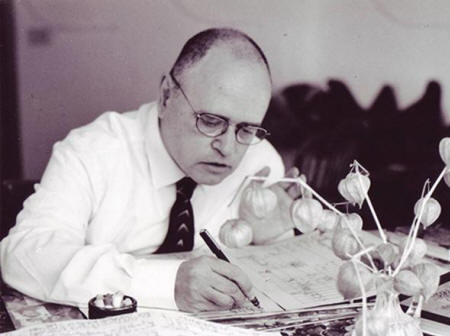

Partner Heinz-Klaus Metzger, Rocco Quaglia
 Sylvano Bussotti (1 October 1931 – 19 September 2021) was an Italian composer of contemporary classical music, also a painter, set and costume designer, opera director and manager, writer and academic teacher. Openly gay, Bussotti expressed his sexuality in his music as early as 1958, when it was socially dangerous to do so. His partner
since 1970, and spouse, was Rocco Quaglia, a ballet dancer and choreographer
with whom he collaborated in many projects. Italian composer and artist Sylvano Bussotti has created the most dramatic and unusual graphic scores of
the post-World War II avant-garde. He is also among the most important artists to bring a polymorphous
sexuality onto the operatic and concert stage.
Sylvano Bussotti (1 October 1931 – 19 September 2021) was an Italian composer of contemporary classical music, also a painter, set and costume designer, opera director and manager, writer and academic teacher. Openly gay, Bussotti expressed his sexuality in his music as early as 1958, when it was socially dangerous to do so. His partner
since 1970, and spouse, was Rocco Quaglia, a ballet dancer and choreographer
with whom he collaborated in many projects. Italian composer and artist Sylvano Bussotti has created the most dramatic and unusual graphic scores of
the post-World War II avant-garde. He is also among the most important artists to bring a polymorphous
sexuality onto the operatic and concert stage.
Born into an artistic, cosmopolitan family in Florence on October 1, 1931, Bussotti was encouraged to express himself from an early age. He studied violin from the age of five and enrolled at the Cherubini Conservatory when he was nine, then audaciously abandoned the Conservatory at the age of thirteen for independent study in composition. In 1956 he traveled to Paris to study with composer Max Deutsch, a student of Schoenberg. There he met Pierre Boulez, already notorious for his early compositions, among other notable musicians and artists. In 1957 Bussotti met Heinz-Klaus Metzger, philosopher Theodor Adorno's most brilliant music student, and within a year they were lovers. Metzger's intellectual and political aesthetics were major influences on Bussotti's early works, until some years after their breakup on Christmas 1963. Metzger brought Bussotti to the famous Darmstadt summer courses in new music in 1958, where he met the composer John Cage, among many others. At Darmstadt, Bussotti wrote his first mature works, including due voci (1958), the score of which was "corrected" by Boulez. Bussotti triumphed at Karlheinz Stockhausen's seminar on music and graphics in 1959 with the five piano pieces for david tudor, excerpted from his homoerotic song cycle pièces de chair II (1958-1960). Works of this period, including sette fogli (1959) and siciliano (1962) for twelve male voices, represent an attack on formalism through beautifully drawn deconstructions of notation and linearity.
Bussotti's flamboyant behavior evidently created discomfort in Darmstadt among closeted gay composers such as Boulez and straight ones such as Stockhausen and Luigi Nono. His work emphasized the contrasts between the highly structured techniques of serialism and the freedom of indeterminacy; he thus helped intensify the already competitive atmosphere of the Darmstadt courses into one of hostility, and contributed to the divisions that followed in European avant-garde music in the early 1960s. Bussotti himself left the courses in late 1961 after a quarrel over fees and never returned. Bussotti continued to build on his notoriety in the 1960s, and also on his relationships with musicians. The controversial and self-consciously decadent la passion selon Sade (1964) joined music, theater, lighting, and costumes in a tangle of symbolic seductions. The work was constructed around Cathy Berberian, not only as vocalist (who plays Justine, Juliette, and Pauline Réage's masochistic O all at once), but possibly also in reflection of her then-ended relationship with composer Luciano Berio. After the rara requiem of 1969-1970, Bussotti's works, including the operas Lorenzaccio (1972), Le Racine (1980), and L'Ispirazione (1988), were more traditionally composed and notated, though often based on erotic or campy subjects. Ballets such as Bergkristall (1974) frequently featured his lover, the dancer Rocco Quaglia. Bussotti became known for his grand opera productions. His extravagant costumes and sets emphasize rich fabrics and beautiful bodies. He was artistic director of La Fenice from 1975 to 1983; his reputation in avant-garde circles declined, but he became an Italian celebrity. He became music director of the Venice Biennale in the late 1980s; he staged a flashy resignation in 1991, bringing in a famous prostitute to give the keynote speech. Erotic activity abounds in Bussotti's works, but with little distinction between gay and straight. A polymorphous expression of sensuality is his chief tool in dissolving the rigidity of modernism.
My published books: